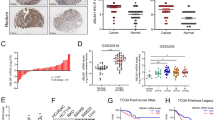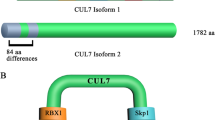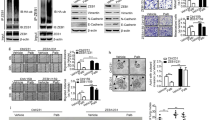Abstract
Cullin 3 (Cul3)-family ubiquitin ligases use the BTB-domain-containing proteins for the recruitment of substrates, but the regulation of this family of ubiquitin ligases has not been completely understood. KLHL20 is a BTB-family protein and targets tumor suppressor promyelocytic leukemia protein (PML) and death-associated protein kinase (DAPK) to its kelch-repeat domain for ubiquitination and degradation. Here, we show that another BTB-kelch protein KLHL39 is recruited to the substrate-binding domain of KLHL20 but is not a substrate of Cul3–KLHL20 complex. Interestingly, KLHL39 does not bind Cul3 because of the absence of certain conserved residues in the BTB domain. Instead, KLHL39 blocks KLHL20-mediated ubiquitination of PML and DAPK by disrupting the binding of these substrates to KLHL20 as well as the binding of KLHL20 to Cul3. Through the two mechanisms, KLHL39 increases the stability of PML and DAPK. In human colon cancers, downregulations of KLHL39, PML and DAPK are associated with metastatic progression. Furthermore, preclinical data indicate that KLHL39 promotes colon cancer migration, invasion and survival in vitro and metastasis in vivo through a PML- and DAPK-dependent mechanism. Our study identifies KLHL39 as a negative regulator of Cul3-KLHL20 ubiquitin ligase and reveals a role of KLHL39-mediated PML and DAPK stabilization in colon cancer metastasis.
This is a preview of subscription content, access via your institution
Access options
Subscribe to this journal
Receive 50 print issues and online access
$259.00 per year
only $5.18 per issue
Buy this article
- Purchase on Springer Link
- Instant access to full article PDF
Prices may be subject to local taxes which are calculated during checkout







Similar content being viewed by others
References
Nguyen DX, Bos PD, Massague J . Metastasis: from dissemination to organ-specific colonization. Nat Rev Cancer 2009; 9: 274–284.
Valastyan S, Weinberg RA . Tumor metastasis: molecular insights and evolving paradigms. Cell 2011; 147: 275–292.
Petroski MD, Deshaies RJ . Function and regulation of cullin-RING ubiquitin ligases. Nat Rev Mol Cell Biol 2005; 6: 9–20.
Genschik P, Sumara I, Lechner E . The emerging family of CULLIN3-RING ubiquitin ligases (CRL3s): cellular functions and disease implications. EMBO J 2013; 32: 2307–2320.
Pintard L, Willems A, Peter M . Cullin-based ubiquitin ligases: Cul3–BTB complexes join the family. EMBO J 2004; 23: 1681–1687.
Perez-Torrado R, Yamada D, Defossez PA . Born to bind: the BTB protein–protein interaction domain. Bioessays 2006; 28: 1194–1202.
Lee YR, Yuan WC, Ho HC, Chen CH, Shih HM, Chen RH . The Cullin 3 substrate adaptor KLHL20 mediates DAPK ubiquitination to control interferon responses. EMBO J 2010; 29: 1748–1761.
Yuan WC, Lee YR, Huang SF, Lin YM, Chen TY, Chung HC et al. A Cullin3-KLHL20 ubiquitin ligase-dependent pathway targets PML to potentiate HIF-1 signaling and prostate cancer progression. Cancer Cell 2011; 20: 214–228.
Bialik S, Kimchi A . DAP-kinase as a target for drug design in cancer and diseases associated with accelerated cell death. Semin Cancer Biol 2004; 14: 283–294.
Gozuacik D, Kimchi A . DAPk protein family and cancer. Autophagy 2006; 2: 74–79.
Chen HY, Lee YR, Chen RH . The functions and regulations of DAPK in cancer metastasis. Apoptosis 2014; 19: 364–370.
Bernardi R, Pandolfi PP . Structure, dynamics and functions of promyelocytic leukaemia nuclear bodies. Nat Rev Mol Cell Biol 2007; 8: 1006–1016.
Salomoni P, Ferguson BJ, Wyllie AH, Rich T . New insights into the role of PML in tumour suppression. Cell Res 2008; 18: 622–640.
Gurrieri C, Capodieci P, Bernardi R, Scaglioni PP, Nafa K, Rush LJ et al. Loss of the tumor suppressor PML in human cancers of multiple histologic origins. J Natl Cancer Inst 2004; 96: 269–279.
Reineke EL, Liu Y, Kao HY . Promyelocytic leukemia protein controls cell migration in response to hydrogen peroxide and insulin-like growth factor-1. J Biol Chem 2010; 285: 9485–9492.
Yen CC, Tsao YP, Chen PC, Wu YC, Liu JH, Pan CC et al. PML protein as a prognostic molecular marker for patients with esophageal squamous cell carcinomas receiving primary surgery. J Surg Oncol 2011; 103: 761–767.
Wolff T, O'Neill RE, Palese P . NS1-binding protein (NS1-BP): a novel human protein that interacts with the influenza A virus nonstructural NS1 protein is relocalized in the nuclei of infected cells. J Virol 1998; 72: 7170–7180.
Tsai PL, Chiou NT, Kuss S, Garcia-Sastre A, Lynch KW, Fontoura BM . Cellular RNA binding proteins NS1-BP and hnRNP K regulate influenza A virus RNA splicing. PLoS Pathogen 2013; 9: e1003460.
Sasagawa K, Matsudo Y, Kang M, Fujimura L, Iitsuka Y, Okada S et al. Identification of Nd1, a novel murine kelch family protein, involved in stabilization of actin filaments. J Biol Chem 2002; 277: 44140–44146.
Ohta Y, Fujimura L, Nishio S, Arima M, Sakamoto A, Shimada H et al. A kelch family protein Nd1-L functions as a metastasis suppressor in cancer cells via Rho family proteins mediated mechanism. Int J Oncol 2010; 36: 427–434.
Xu L, Wei Y, Reboul J, Vaglio P, Shin TH, Vidal M et al. BTB proteins are substrate-specific adaptors in an SCF-like modular ubiquitin ligase containing CUL-3. Nature 2003; 425: 316–321.
Wang WJ, Kuo JC, Yao CC, Chen RH . DAP-kinase induces apoptosis by suppressing integrin activity and disrupting matrix survival signals. J Cell Biol 2002; 159: 169–179.
Ebert MP, Mooney SH, Tonnes-Priddy L, Lograsso J, Hoffmann J, Chen J et al. Hypermethylation of the TPEF/HPP1 gene in primary and metastatic colorectal cancers. Neoplasia 2005; 7: 771–778.
Schneider-Stock R, Kuester D, Ullrich O, Mittag F, Habold C, Boltze C et al. Close localization of DAP-kinase positive tumour-associated macrophages and apoptotic colorectal cancer cells. J Pathol 2006; 209: 95–105.
Xu XL, Yu J, Zhang HY, Sun MH, Gu J, Du X et al. Methylation profile of the promoter CpG islands of 31 genes that may contribute to colorectal carcinogenesis. World J Gastroenterol 2004; 10: 3441–3454.
Chen HY, Lin YM, Chung HC, Lang YD, Lin CJ, Huang J et al. miR-103/107 promote metastasis of colorectal cancer by targeting the metastasis suppressors DAPK and KLF4. Cancer Res 2012; 72: 3631–3641.
Rabellino A, Carter B, Konstantinidou G, Wu SY, Rimessi A, Byers LA et al. SUMO E3-ligase PIAS1 regulates the tumor suppressor PML and its oncogenic counterpart PML-RARA. Cancer Res 2012; 72: 2275–2284.
Scaglioni PP, Yung TM, Cai LF, Erdjument-Bromage H, Kaufman AJ, Singh B et al. A CK2-dependent mechanism for degradation of the PML tumor suppressor. Cell 2006; 126: 269–283.
Wolyniec K, Shortt J, de Stanchina E, Levav-Cohen Y, Alsheich-Bartok O, Louria-Hayon I et al. E6AP ubiquitin ligase regulates PML-induced senescence in Myc-driven lymphomagenesis. Blood 2012; 120: 822–832.
Wu HC, Lin YC, Liu CH, Chung HC, Wang YT, Lin YW et al. USP11 regulates PML stability to control Notch-induced malignancy in brain tumours. Nat Commun 2014; 5: 3214.
Komatsu M, Kurokawa H, Waguri S, Taguchi K, Kobayashi A, Ichimura Y et al. The selective autophagy substrate p62 activates the stress responsive transcription factor Nrf2 through inactivation of Keap1. Nat Cell Biol 2010; 12: 213–223.
Ma J, Cai H, Wu T, Sobhian B, Huo Y, Alcivar A et al. PALB2 interacts with KEAP1 to promote NRF2 nuclear accumulation and function. Mol Cell Biol 2012; 32: 1506–1517.
Camp ND, James RG, Dawson DW, Yan F, Davison JM, Houck SA et al. Wilms tumor gene on X chromosome (WTX) inhibits degradation of NRF2 protein through competitive binding to KEAP1 protein. J Biol Chem 2012; 287: 6539–6550.
Hast BE, Goldfarb D, Mulvaney KM, Hast MA, Siesser PF, Yan F et al. Proteomic analysis of ubiquitin ligase KEAP1 reveals associated proteins that inhibit NRF2 ubiquitination. Cancer Res 2013; 73: 2199–2210.
Zhuang M, Calabrese MF, Liu J, Waddell MB, Nourse A, Hammel M et al. Structures of SPOP–substrate complexes: insights into molecular architectures of BTB-Cul3 ubiquitin ligases. Mol Cell 2009; 36: 39–50.
Canning P, Cooper CD, Krojer T, Murray JW, Pike AC, Chaikuad A et al. Structural basis for Cul3 protein assembly with the BTB-Kelch family of E3 ubiquitin ligases. J Biol Chem 2013; 288: 7803–7814.
Errington WJ, Khan MQ, Bueler SA, Rubinstein JL, Chakrabartty A, Prive GG . Adaptor protein self-assembly drives the control of a cullin-RING ubiquitin ligase. Structure 2012; 20: 1141–1153.
Ji AX, Prive GG . Crystal structure of KLHL3 in complex with Cullin3. PLoS One 2013; 8: e60445.
Wang WJ, Kuo JC, Ku W, Lee YR, Lin FC, Chang YL et al. The tumor suppressor DAPK is reciprocally regulated by tyrosine kinase Src and phosphatase LAR. Mol Cell 2007; 27: 701–716.
Liu X, Zhang H, Lai L, Wang X, Loera S, Xue L et al. Ribonucleotide reductase small subunit M2 serves as a prgnostic biomarker and predicts poor survival of colorectal cancers. Clin Sci 2013; 124: 567–578.
Acknowledgements
We thank National RNAi Core Facility for RNAi. This work was supported by Academia Sinica Investigator Award (RHC) and Aim for the Top University Project from Taipei Medical University (HYC).
Author information
Authors and Affiliations
Corresponding author
Ethics declarations
Competing interests
The authors declare no conflict of interest.
Additional information
Supplementary Information accompanies this paper on the Oncogene website
Supplementary information
Rights and permissions
About this article
Cite this article
Chen, H., Hu, J., Chen, T. et al. KLHL39 suppresses colon cancer metastasis by blocking KLHL20-mediated PML and DAPK ubiquitination. Oncogene 34, 5141–5151 (2015). https://doi.org/10.1038/onc.2014.435
Received:
Revised:
Accepted:
Published:
Issue Date:
DOI: https://doi.org/10.1038/onc.2014.435
This article is cited by
-
Kelch-like proteins in the gastrointestinal tumors
Acta Pharmacologica Sinica (2023)
-
A novel HIF1α-STIL-FOXM1 axis regulates tumor metastasis
Journal of Biomedical Science (2022)
-
Targeted protein degradation: expanding the toolbox
Nature Reviews Drug Discovery (2019)
-
Identification of expression patterns in the progression of disease stages by integration of transcriptomic data
BMC Bioinformatics (2016)
-
Cul3-KLHL20 ubiquitin ligase: physiological functions, stress responses, and disease implications
Cell Division (2016)



